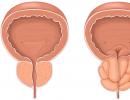17. Useless and harmful exercise. Part 4 Hyperextensions and round back
Useless and harmful exercise. Part 4 Hyperextensions and round back.
Our only physical support in the human body is the spinal column, to which everything else is attached. The spine in an upright position is tensioned by gravity. When we just lie, there is also pressure there due to the ligaments and muscles pressing the intervertebral segments. In the position of hanging on the arms, the pressure does not go away, the muscles are in good shape all the time, otherwise there would be an overstretching of the ligaments and instability in the spine, it would simply rupture over time.
Consider the structure of the spine. In total, there are 32-34 vertebrae, which are divided into departments:
The cervical spine occupies 7 vertebrae, numbered C1-C7
Thoracic - 12 vertebrae, numbered T1-T12 or D2-D12
Lumbar - 5 vertebrae, numbered L1-L5
Sacral region - 5 vertebrae, numbered S1-S5
Coccygeal region - 3-5 vertebrae, which grow together over time, numbering Co1-Co5
The spine has 3 bends - cervical lordosis, thoracic kyphosis, lumbar lordosis. The spine consists of vertebral bodies, between which are intervertebral discs (MPD). Mpd consists of the annulus fibrosus and the nucleus pulposus inside, which receive the main load, serving as movable shock absorbers. The spinal cord runs through the spinal canal, which innervates various parts of the body and organs.


When the spine is bent in the sagittal plane (tilt of the body forward and downward), the vertebral bodies also change their angle, the edges in front of the spine come closer, the fibrous ring is compressed and abuts against the posterior longitudinal ligament, which is located in front of the spinal canal and protects the spinal cord.
When the spine is overextended in the sagittal plane, the same thing happens, only the fibrous ring already tends to the anterior longitudinal ligament, where there is no spinal cord, here the spinous processes approach each other. With lateral tilts in the frontal plane, the vertebral bodies also change their angle.
![]()
These bends and any movements of the spine are natural for life. However, with age, from poor nutrition and a sedentary lifestyle, improper posture, excessive load and excessively long stay of the vertebrae in the wrong position, the properties of the annulus fibrosus are lost. Dystrophic changes begin, which are called osteochondrosis of the spine with different stages. Today, even adolescents have it, not to mention mature people. It manifests itself as discomfort and pain in the muscles that surround the spine. At the stage of protrusion and intervertebral hernia, the annulus fibrosus, the nucleus pulposus, crawls out into the spinal canal and compresses the nerves in the spinal canal, manifesting itself in various ailments and pains.


One of the most serious problems of the fitness industry is the risk of injury to the spine, due to incorrect exercise technique, not adhering to the principle of individuality, and the propaganda of deliberately incorrect exercises! As a result, the practitioners intensify the existing osteochondrosis, and those who do not get it. And this is not only from not correct hyperextensions, but from many exercises with their own weight, on simulators, with free weights.
Today we'll talk about hyperextension... There are many options for doing the exercise, and practitioners use everything they can and rarely do the exercise correctly, even experienced ones.

Option 1 most used among beginners.
Working muscle groups - the back of the thigh, buttocks and spine extensors in dynamics. An exercise is performed with a rounding of the back at the bottom point and overextension at the top point + often with inertia and additional weight. This is the most traumatic option, where the entire spine suffers - the fibrous ring, spinal ligaments, tendons of the leg muscles. There is a strong instability of the spine and the vertebrae over time can be displaced against the background of osteochondrosis. The destroyed ligaments of the spine cannot be restored, as well as the annulus fibrosus.
Option 2, where the movements of the spine are wavy and in dynamics - as dangerous as the first one + displacement of the vertebrae can occur right during the exercise, especially with weight.
Option 3, it is used by many, from experienced to beginners.
The height of the stop is set at the level of the sub-gluteal folds in order to tilt the pelvis forward, relative to the hips. The thoracic region is initially rounded off and retained this position throughout the movement of the body. Here, the lumbar region is often rounded up for beginners. Working muscle groups - the back of the thigh, buttocks in dynamics, in statics, the extensors of the back. When the lower back is rounded, the back extensors work in dynamics. If we exclude rounding of the back (which is very traumatic), the exercise becomes less traumatic, but not safe. This technique is considered incorrect and is excluded from fitness. We recall the picture where the vertebral bodies have changed their angle of inclination in the thoracic region (thoracic kyphosis is increased). Now we add the muscles that extend the spine and see what happens. The muscles that extend the spine create additional compression on the close corners of the vertebral body when moving up.
 It turns out a similar exercise with a deadlift and a round chest, which experienced practitioners are afraid of. And at the lowest point, when lowering the body, there is a stretching of the extensors of the spine, including the cervical spine, and additional uniform compression of the entire spine. Thus, this exercise increases osteochondrosis, which is present in many, and in a healthy spine it causes instability of the vertebrae in the thoracic region, due to stretching of the posterior longitudinal ligament.
It turns out a similar exercise with a deadlift and a round chest, which experienced practitioners are afraid of. And at the lowest point, when lowering the body, there is a stretching of the extensors of the spine, including the cervical spine, and additional uniform compression of the entire spine. Thus, this exercise increases osteochondrosis, which is present in many, and in a healthy spine it causes instability of the vertebrae in the thoracic region, due to stretching of the posterior longitudinal ligament.


Option 4 less traumatic than option 3. The height of the stops - as high as possible. In statics, the buttocks and the back of the thigh work, in dynamics, the extensors of the back. Here the pelvis does not tilt at all, the spine is flexed in the chest area and is extended. The extensors of the back are well worked out, but they compress the entire spine all the time throughout the entire movement, which means they are traumatic for osteochondrosis, with a healthy spine they can be done without being carried away by excessive additional weight.
Option 5 the safest. Here, the height of the stops is at the level of the gluteal fold, the working muscle groups in dynamics are the buttocks and the back of the thigh, in statics - the extensors of the back. There is no overextension of the spine (the body rises to the plane of the hips), and at the lowest point the back is not rounded. The natural deflection of the spine in the thoracic and lumbar spine is maintained throughout the entire range of motion. It is difficult to track the technique on your own, you need to do it with a stick, and look from the side of the coach.
Some subtleties. In all variants, the calf muscles work in statics. The legs at the knee joint should not be completely straight, but should be kept slightly bent to avoid overstretching the popliteal ligaments and knee instability.
The cervical spine is the most vulnerable, you cannot put a barbell on it!
Hyperextension with spinal rotation (vertical rotation) should also be excluded due to the increased risk of injury.
An absolute contraindication to all hyperextensions is an intervertebral hernia on a thin leg behind the spine, which can fall off into the spinal canal and compress the nerves.
The work of the gluteal muscles throughout the entire range of motion and stretching of the back of the thigh are important. In order for the gluteal muscles to work well, you need to activate them with other exercises, and at the top point they need to be additionally strained by mixing.
Conclusions:
The only harmless hyperextension exercise is option 5, where the spine maintains a natural position throughout the movement. All other variants cause degenerative-dystrophic changes in the spine. Option 4 can be done for healthy people with low body weight.
On the real misconceptions associated with a round back:
I have intervertebral hernias and the doctor prescribed it to me, said that it was necessary to round the back. I have been doing it for 5 years with a round back and the pains are gone, I feel good. I don’t know what kind of doctor prescribed this for you, but back pain goes away because of the pain-relieving hormones that are released during strength training. Take a picture of the spine and see if there is a progression of osteochondrosis? Most likely, it is explicit
For 10 years I have been practicing and rounding my back - my back hardly hurts. Are you waiting until you get completely sick?
The coach told me to do with a round back, my spine is healthy and did not hurt. Pain is a consequence of osteochondrosis, which can manifest itself at the initial stage, and already on an intervertebral hernia, when it is too late. Spinal osteochondrosis is not treated, you need to keep it healthy
I am completely healthy, long-term training, I can do in different ways. The body has certain resources for recovery, including the spine, which should not be wasted just like that.
I warm up and warm up my back, I have a deadlift in front of me. With such a warm-up, you yourself create possible instability of the vertebrae, which you will finish off with deadlift. It is better to lubricate the spine on articular gymnastics, where from a standing position you tilt the spine in different directions, and the back muscles warm up well during the warm-up approaches of the deadlift.
It is convenient for me to do so, which means it is safe for me. Of course, it's more convenient to do this, tk. it is easier to do exercises without control and stabilization of anything. However, there are no pain receptors in the intervertebral disc, you do not feel like you are killing your spine until the hernia or protrusion comes out, but it will be too late. It is wise here to learn from the mistakes of others' past.






